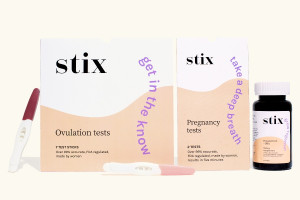This New IVF Treatment Is a Cheaper Option for Infertility Patients
INVOcell, an FDA-approved fertility treatment now offered at Main Line Fertility, costs roughly 40 percent less than traditional In Vitro Fertilization.

After struggling with infertility for nearly two years, Andrea and Randy Missimer learned they’ll soon be welcoming a baby to the family thanks to a new In Vitro Fertilization (IVF) treatment called INVOcell. / Courtesy
Andrea and Randy Missimer received a special gift for Christmas this year. After struggling with infertility for nearly two years, the couple learned they’ll soon welcome a baby to the family thanks to a new In Vitro Fertilization (IVF) treatment called INVOcell.
After visiting multiple centers and trying unsuccessfully to use other costlier methods, the Missimers were referred to Main Line Fertility physician, Ben Gocial, and the medical director at Main Line Fertility, Michael Glassner. Main Line is one of few clinics in the region currently offering the treatment.
Unlike other IVF methods that develop the embryo in a lab, INVOcell is an FDA-approved fertility treatment that uses a woman’s own body as an incubator during fertilization and early embryo development. According to Glassner, the process begins with mild ovarian stimulation that uses fewer fertility medications than other IVF treatments. Once the eggs have been retrieved from the female, the sperm and egg are combined and transferred into the INVOcell device. The device is then inserted in the woman’s vagina, which serves as an incubator for the embryo. After five days, doctors remove the INVOcell device and implant the embryo in the woman’s uterus.

INVOcell is an FDA approved fertility treatment that uses a woman’s own body as an incubator during fertilization and early embryo development. / Courtesy
Glassner says the treatment has several benefits compared to other IVF methods.
“A typical IVF patient might come to the office for more ultrasound and more blood work because they’re on a lot of medications and you have to make sure you’re monitoring the medication accordingly,” Glassner explained. “With INVOcell, you’re on fewer medications, you only have two visits to the office and you’re not being stimulated as aggressively, which some people find to be inviting.”
Doctors at Penn Medicine say they also offer INVOcell and have had several successful births using the treatment. However, Clarisa Gracia, director of fertility preservation at Penn Medicine said studies show that INVOcell patients and patients who use traditional IVF methods have similar pregnancy and live birth rates.
Still, patients like Andrea say they prefer the newer method for psychological reasons.
“I felt more a part of the process. It’s like I’m producing it versus it sitting in the lab for a few days and just watching it,” Andrea said. “We got to do it as a couple, and I got to carry it. That felt special.”
The treatment also offers a unique experience for same-sex couples where both partners have uteruses. One partner can undergo the egg retrieval process and incubate the embryos with the INVOCELL, and then the embryos can be transferred to the other partner who will carry the pregnancy.
Glassner says one of the most important benefits of INVOcell is that it’s relatively cheaper than other IVF methods. In the United States, the average fertility patient spends around $12,000 to $15,000 per IVF cycle depending on several factors, including insurance. Not all insurances cover IVF. Since most IVF patients require two or more cycles to achieve a successful pregnancy, that cost can quickly increase to upwards of $35,000. Glassner says pricing for INVOcell is set by individual clinics but the process is estimated to cost around $8,500 per cycle, roughly a 40 percent reduction in cost compared to traditional IVF.
“I didn’t come from a rich family, nor did my husband,” Andrea said. “We were glad they were able to work with us on the costs.”
“No family should have to forgo having children because they don’t have good insurance or because the costs are too high,” said Glassner. “It’s our job to empower patients especially when they’re faced with a medical issue like fertility and feeling powerless. By giving them options, we’re empowering them. This is a viable option for most couples going through IVF and they should know it’s an option, even if it’s not offered where they receive care.”
Fortunately for Andrea, she got pregnant on her first round of INVOcell. With insurance, she estimates the couple spent a total of $9,000, including medications, copays, and the actual procedure and device.
“When the doctor called and said I was pregnant, I lost it,” Andrea said. “I was crying tears of joy because it’s been a long road.”
The Missimers expect to welcome a healthy baby in June 2020. They announced the news to their families on Christmas morning.


